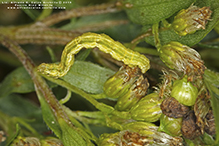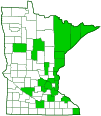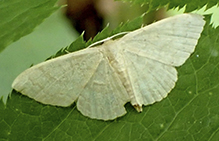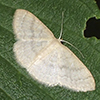common tan wave
(Pleuroprucha insulsaria)
Conservation • Description • Habitat • Ecology • Distribution • Taxonomy
|
|
||||||||||||||||||
Description |
Common tan wave is a small, short-lived, geometer moth. It occurs in North, Central, and South America. In the United States it occurs in the Great Plains and in every state east of the Great Plains. It is common in the eastern half of the United States, less common in the eastern half of Minnesota, where it nears the western limit of its range. It is found from early June to early September in agricultural fields, field edges, deciduous woodlands, and forest openings. It is a minor agricultural pest of corn but causes little damage. Adults are ¼″ (7.0 to 7.5 mm) long and slender. They have relative large wings, with a wingspan of 9⁄16″ to 13⁄16″ (14 to 21 mm). The forewings and hindwings are similar: triangular, mottled, and pale yellowish-brown with a faint, almost imperceptible greenish tinge. The outer edges are slightly scalloped. There is a dark antemedial line (AM line) with three black dots; a dark postmedial line (PM line); and a thin, white, scalloped, submarginal line with a broader, dark, inner border and a dark reddish-brown dot on each vein. On some individuals all of the lines are distinct. On others the AM and subterminal lines may be barely discernible. There is no discal spot. The fringe is very long. The antennae on the female are thread-like (filiform). The lower half of the antennae on the male are feather-like with branches on one side only (pectinate). The mature larvae (caterpillar) is about ⅝″ (1.5 cm.) long and highly variable in appearance. It may be yellow, green, gray, or brown, and it has white and brown markings. The hardened plate (prothoracic shield) on the upper side of the first segment of the thorax (T1) often has a pale, thin stripe in the middle (middorsal stripe) and broader subdorsal stripes. When viewed from above T2 and T3 are noticeably swollen. On the thorax and abdomen there is a well-developed middorsal stripe and a white stripe through the row of breathing pores (spiracular stripe). On the first five abdominal segments there is often a large, dark chevron with a pale rear (posterior) margin on each side of the middorsal stripe. The are only two pairs of fleshy, leg-like structures (prolegs), one pair each on the sixth and last abdominal segments. |
Size |
Total length: ¼″ (7.0 to 7.5 mm) Wingspan: 9⁄16″ to 13⁄16″ (14 to 21 mm) |
Similar Species |
Habitat |
Agricultural fields, field edges, deciduous woodlands, and forest openings. |
Ecology |
Season |
Three generations. Early June to early September. |
Behavior |
Caterpillars feed during the day and often hang from a short thread at night, possibly to escape predators. Adults are active at night and will come to lights. They spend the day on the underside of a leaf and will fly if disturbed. They rest with wings spread out and flattened to the leaf surface. |
Life Cycle |
|
Larva Hosts |
Mostly fresh corn silk. When that is not available, also trees and low plants, including bittersweet, bedstraw, goldenrod, oak, willow, sumac, aster, joe pye weed, and other plants |
Adult Food |
Pupa overwinter. Adults are short-lived, lasting an average of just 6.4 days. |
Distribution |
||
|
Sources |
|
| 8/30/2024 | ||
Occurrence |
||
Common in eastern U.S., less common in Minnesota |
||
Taxonomy |
|
Order |
|
Superfamily |
Geometroidea (Geometrid and Swallowtail Moths) |
Family |
|
Subfamily |
Sterrhinae (waves and mochas) |
Tribe |
Cosymbiini |
Genus |
Pleuroprucha |
Subordinate Taxa |
|
|
|
Synonyms |
|
Acidalia insulsaria Acidalia invariata Acidalia persimilata Acidalia placidaria Pleuroprucha insularia |
|
Common Names |
|
common tan wave common tan wave moth |
|
Glossary
Antemedial (AM) line
A thin line separating the basal area and the median area of the forewing of Lepidoptera.
Postmedial (PM) line
A thin line separating the median area and the postmedial area of the forewing of Lepidoptera.
Proleg
A fleshy structure on the abdomen of some insect larvae that functions as a leg, but lacks the five segments of a true insect leg.
Prothoracic shield
The hardened plate on the dorsal surface of the first segment of the thorax.
Visitor Photos |
||
Share your photo of this insect. |
||
This button not working for you? |
||
Babette Kis |
||
 |
||
| Pleuroprucha insularia common tan wave |
|
|
Alfredo Colon |
||
 |
|
|
MinnesotaSeasons.com Photos |
||
|
||
|
||

Slideshows |
|

Visitor Videos |
||
Share your video of this insect. |
||
This button not working for you? |
||
|
Other Videos |
||
|

Visitor Sightings |
||
Report a sighting of this insect. |
||
This button not working for you? |
||
| Babette Kis 8/8/2022 |
Location: Barnes Prairie, Racine Co., WI
|
| Babette Kis 7/4/2020 |
Location: Barnes Prairie, Racine Co., WI
|
| Alfredo Colon 9/3 to 9/5/2019 |
Location: Woodbury, Minnesota |
 |
MinnesotaSeasons.com Sightings |
||
|

Created: 5/23/2020 Last Updated: © MinnesotaSeasons.com. All rights reserved. |



